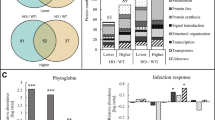Summary
Pairs of susceptible and resistant, near-isogenic cultivars ofHordeum vulgare which differ for the Mla, Mlk and Mlp genes for resistance toErysiphe graminis f. sp.hordei were inoculated with race 3 of this pathogen and patterns of protein synthesis associated with primary infection mapped using pulse-labelling with L-[35S]methionine and 2-dimensional electrophoresis. Extraction of proteins with buffer containing detergent revealed the enhanced synthesis of 5 and 8 polypeptides at 25 and 30 h respectively after inoculation of barley carrying the Mla gene (cvMla). The enhanced synthesis of these same polypeptides together with 11 additional polypeptides was observed at 48 h and 72 h after inoculation of barley carrying either the Mlp (cvMlp) or Mlk (cvMlk) genes. The labelling of several major constitutive polypeptides was suppressed in cvMla at 24 h after inoculation; the labelling of six of these polypeptides was also suppressed in both cvMlp and cvMlk but not until 48 and 72 h after inoculation. These results indicate that changes occur in the synthesis of some common polypeptides following infection of cultivars carrying different resistance genes but the timing and extent of these changes varies with the resistance gene in the host.
Similar content being viewed by others
References
Bell AA: Biochemical mechanisms of disease resistance. Ann Rev Plant Physiol 32:21–81, 1981.
Bushnell WR: Hypersensitivity in rusts and powdery mildews. In: Plant infection: the physiological and biochemical basis. Asada Y, Bushnell WR, Ouchi S, Vance CP (eds.). Japan Sci Press, Tokyo/Springer-Verlag, Berlin, 1982, pp 97–116.
Chamberlain JP: Fluorographic detection of radioactivity in polyacrylamide gels with the water-soluble fluor, sodium salicylate. Anal Biochem 98:132–135, 1979.
Chua NH: Electrophoretic analysis of chloroplast proteins. Methods Enzymol 69C:434–445, 1980.
Day PR, Barrett JA, Wolfe MS: The evolution of host-parasite interaction. In: Genetic engineering of plants: an agricultural perspective. Kosuge T, Meredith CP, Hollaender A (eds). Plenum Publishing Corp, NY, 1983, pp 419–430.
Ellingboe AH: Genetics and physiology of primary infection byErysiphe graminis. Phytopathology 62:401–406, 1972.
Ellingboe AH: Genetical aspects of active defence. In: Active defense mechanisms in plants. Wood RKS (ed). Academic Press, New York, 1982, pp 179–192.
Gabriel DW, Ellingboe AH: High resolution two-dimensional electrophoresis of proteins from congenic wheat lines differing by single resistance genes. Physiol Plant Pathol 20:349–357, 1982.
Giese H: Powdery mildew resistance genes in the Mla and Mlk regions on barley chromosome 5. Hereditas 95:51–62, 1981.
Green NE, Hadwiger LA, Graham SO: Phenylalanine ammonia-lyase, tyrosine ammonia-lyase and lignin in wheat inoculated withErysiphe graminis f. sp.tritici. Phytopathology 65:1071–1074, 1975.
Hsu SC, Ellingboe AH: Elongation of secondary hyphae and transfer of [35S] from barley toErysiphe graminis f. sp.hordei during primary infection. Phytopathology 62:876–882, 1972.
Jensen J: Coordinator's report: Chromosome 5. Barley Genet Newsl 10:88–90, 1980.
Johnson LEB, Bushnell WR, Zeyen RJ: Binary pathways for analysis of primary infection and host response in populations of powdery mildew fungi. Can J Bot 57:497–511, 1979.
Keen NT, Brueggar B: Phytoalexins and chemicals that elicit their production in plants. Chem Soc Symp Ser 62:1–26, 1977.
Manners JM, Scott KJ: Translational activity of polysomes of barley leaves during infection byErysiphe graminis f. sp.hordei. Phytopathology 73:1386–1392, 1983.
Manners JM, Scott KJ: The effect of infection byErysiphe graminis f. sp.hordei on protein synthesisin vivo in leaves of barley. Plant and Cell Physiol. In press.
Masri SS, Ellingboe AH: Primary infection of wheat and barley byErysiphe graminis. Phytopathology 56:389–395, 1966.
Moseman JG: Isogenic barley lines for reaction toErysiphe graminis f. sp.hordei. Crop Sci 12:681–682, 1972.
O'Farrell PH: High resolution two dimensional electrophoresis of proteins. J Biol Chem 250:4007–4021, 1975.
Tani T, Mayama S: Evaluation of phytoalexins and preformed antifungal substances in relation to fungal infection. In: Plant infection: the physiological and biochemical basis. Asada J, Bushnell WR, Ouchi S, Vance CP (eds). Japan Sci Press, Tokyo/Springer-Verlag, Berling, 1982, pp. 301–314.
Wagoner W, Loscke DC, Hadwiger LA: Two-dimensional electrophoretic analysis ofin vivo andin vitro synthesis of proteins in peas inoculated with compatible and imcompatibleFusarium solani. Physiol Plant Pathol 20:99–107, 1982.
Wood RKS: Establishment of Infection. Plant Pathol 33:3–12, 1984.
Yang SL, Moseman JG, Ellingboe AH: The formation of elongating secondary hyphae ofErysiphe graminis and the segregation of M1 genes in barley. Phytopathology 62:1219–1223, 1972.
Author information
Authors and Affiliations
Rights and permissions
About this article
Cite this article
Manners, J.M., Davidson, A.D. & Scott, K.J. Patterns of post-infectional protein synthesis in barley carrying different genes for resistance to the powdery mildew fungus. Plant Mol Biol 4, 275–283 (1985). https://doi.org/10.1007/BF02418246
Received:
Revised:
Accepted:
Issue Date:
DOI: https://doi.org/10.1007/BF02418246




